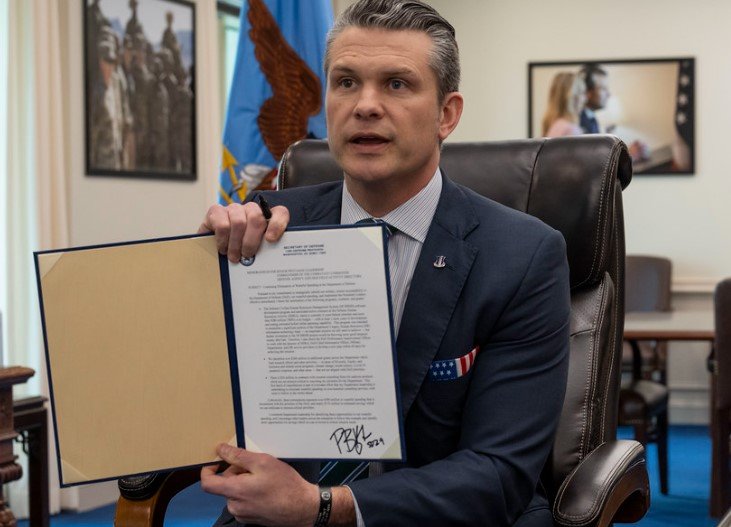The Trump administration is facing fresh scrutiny after it was revealed that U.S. Defence Secretary Pete Hegseth used a second Signal messaging chat to discuss a sensitive military airstrike in Yemen. This new disclosure has ignited further criticism about the handling of classified information during his tenure.
The Trump administration is once again under the spotlight, as new revelations have surfaced regarding the handling of classified information. According to a report by The New York Times, U.S. Defence Secretary Pete Hegseth set up a second Signal messaging group to share details about a military airstrike against Yemen’s Houthi militants. This second group, which included Hegseth’s wife and brother, is now raising concerns about the security of sensitive national defense information.
While Signal is a widely-used messaging app, it is not authorized for discussing classified military operations. Yet, Hegseth reportedly shared crucial details of the March strike in a chat that included his wife, Jennifer Hegseth, and his brother, Phil Hegseth. The group, dubbed “Defense Team Huddle,” was made up of 13 individuals, many of whom had close ties to Hegseth. The inclusion of family members has stirred up criticism, especially given the nature of the conversation.
An Unauthorized Group Chat
The revelation that Hegseth used Signal to discuss sensitive national defense information is troubling on several levels. Signal, while secure for general messaging, is not considered a secure platform for transmitting classified government information. This revelation points to a broader issue regarding the management and security of sensitive communications in the Trump administration. The group chat, which included high-level Pentagon officials and Hegseth’s relatives, contained details about the planned airstrike, including the timing and the weapons systems involved.

Notably, the chat included Hegseth’s wife, Jennifer, a former Fox News producer, and his brother, Phil, who was employed at the Pentagon as a senior adviser and liaison to the Department of Homeland Security. Both have attended high-level meetings and traveled with Hegseth, which further raises questions about the propriety of sharing such information outside of official channels.
The First Chat Controversy
The controversy surrounding the second chat comes on the heels of a previous leak involving a separate Signal chat, which was set up by national security adviser Mike Waltz. That group, which included several Cabinet members, became public when Jeffrey Goldberg, editor-in-chief of The Atlantic, was added to the conversation. In that group, Hegseth shared similar details about the planned strike on Iran-backed Houthi militants.
The leaked information from that first chat revealed that Hegseth had shared a timeline for the airstrike, including the specific weapons systems that would be used. The leak sparked outrage and concerns about national security, as well as the safety of military personnel involved in the operation.
Fresh Criticism and Calls for Accountability
The latest disclosure has prompted renewed criticism of Hegseth, with Senate Democratic Leader Chuck Schumer calling for his removal. Schumer took to social media to express his frustration, stating that Hegseth had put lives at risk by sharing the details of a military operation with unauthorized individuals. The senator also criticized President Donald Trump for not taking action against Hegseth, adding that the defense secretary must be fired.
“This is an ongoing issue. Pete Hegseth keeps putting lives at risk, and Trump is still too weak to take action,” Schumer posted on X, formerly Twitter. “Pete Hegseth must be fired.”
The Pentagon’s Response
The Pentagon has not yet issued a formal response to the latest revelations. However, the matter is currently under investigation by the Department of Defence’s acting inspector general. This investigation was prompted by concerns raised by Senate Armed Services Committee leaders, including Republican Chairman Roger Wicker and Democratic Ranking Member Jack Reed. They have expressed alarm over the potential security breach and the failure to act on the leaks in a timely manner.
While Hegseth has defended his actions, claiming that no classified information was shared in the chat with the journalist, the content of the second chat has raised doubts. According to sources familiar with the investigation, the operational details shared in both chats were classified, and their public release could have endangered military personnel.
Resignations and Fallout at the Pentagon
The fallout from the leak continues to reverberate within the Pentagon. Last week, four officials in Hegseth’s inner circle were asked to leave the department. Among them were Dan Caldwell, Hegseth’s aide, Colin Carroll, the chief of staff to Deputy Defence Secretary Stephen Feinberg, and Darin Selnick, Hegseth’s deputy chief of staff. These individuals were initially placed on leave pending the investigation but were later escorted out of the Pentagon.
Interestingly, Caldwell was identified as the person who facilitated the Signal chat with Trump Cabinet members. His departure, along with the others, has raised further questions about the handling of sensitive information and the potential for leaks within the Pentagon.
Additionally, former Pentagon spokesman John Ullyot announced his resignation, though it was unrelated to the ongoing investigation into the leaks.
